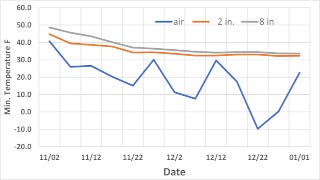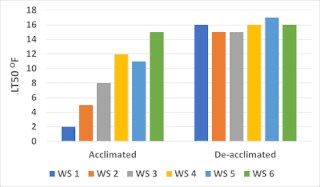By Craig Sheaffer and Nathan Drewitz
Winter snowfall provides recreational activities, snow shoveling, and travel disruption, but for hibernating alfalfa, it provides a blanket of protection against winter air temperatures. So far this winter, the risk of alfalfa winter kill is minimal because throughout much of Minnesota the plants have been well insulated by snow during periods of very low air temperatures.
- Snow as an insulator - Snow is a mixture of air and ice and has low thermal conductivity compared to pure ice and soil. It is a natural insulator of the soil and buffers against low and fluctuating air temperature. Snow cover protects dormant alfalfa plants from freezing and desiccating and reduces the depth and duration of soil freezing (Figure 1).
- Snow structure - Snow varies considerably in moisture content, particle size, and density and continually undergoes change as it ages. Snowpack often has layers of snow with different structure. Fluffy new snow provides the best insulation while partially melted snow transformed to ice is a poor insulator.
- Snow depth is critical to insulating the soil. Snow depths of 4 to 10 inches have been shown to provide effective insulation. Figure 2 shows rather constant soil temperatures in December 2022 during periods of very low air temperatures with snow depths from 4 to 12 inches. Alfalfa crowns are also protected from air temperatures because crowns are typically buried from 1-2 inches in the soil.

Figure 2. Trends in minimum air, 2 in. and 8 in. soil temperatures (°F) from Nov. 2 2022 to Jan. 1 2023 at St. Paul, MN. During periods of very low air temperatures in early and late December, the soil was covered with snow between 4 and 12 inches.
- Snow reflects solar energy and reduces absorption of energy that can cause soil warming during the winter months. Temperatures of 40 F and above can cause alfalfa to prematurely break dormancy during winter and be susceptible to subsequent freezing due to resumption of normal winter air temperatures.
Snow and alfalfa
Winter survival of alfalfa is affected by genetics, environment, disease, and management factors. Cold tolerance is a key component of winter survival and cold tolerance is typically greatest during the months of January and February. An average killing temperature of 15 F is often quoted for acclimated alfalfa, but varieties vary greatly in cold tolerance which is influenced by traits such as fall dormancy and crown depth. In addition, some alfalfa breeding companies have selected alfalfa varieties that have a combination of physiological features that increase cold tolerance.

Figure 3. Lethal temperature at which 50% of the alfalfa
plants die (LT50) for six alfalfa varieties varying in winter
survival (WS) ratings. WS1 is extremely winterhardy while
WS6 is not winterhardy.
In our research (Figure 3), we found that extremely winterhardy and very winterhardy (Winter survival ratings 1 and 2) alfalfa varieties could survive short term soil temperatures of 2-5° F. Varieties used in Minnesota should be very winterhardy (WS 2) as described in the Alfalfa Variety Ratings.
Note in Figure 3 that all alfalfa varieties that were deacclimated by warm temperatures have significant injury at temperatures at about 16° F. Previous research in Michigan showed that winterhardy (WS 2) varieties had less winter kill than less winterhardy varieties without snow cover and that winterkill was less under 4 to 8 inches of snow (Table 1). Snowcover had less benefit on winter survival of varieties with winter survival ratings 3 or 5 than varieties with winter survival rating of 2.
Table 1. Effects of snow depth (0, 4, and 8 inches) on winterkill of alfalfa varieties differing in winter survival. Data averaged for two years of extreme minimum air temperatures in Chathum, MI. Winter survival rating where 2 is very winterhardy while 5 is not winterhardy.
| Variety | Winter survival
rating | Winterkill
0 inches snow | Winterkill
4 inches snow | Winterkill
8 inches snow |
|---|
| | | % | % | % |
| Vernal | 2 | 42 | 3 | 6 |
| Magnum IV | 2 | 39 | 22 | 10 |
| Saranac | 3 | 69 | 38 | 29 |
| Nitro | 5 | 98 | 94 | 75 |
Source: Leep et al., 2001. Agron. J. 93:1142-1148.
Snow management
Snow is likely during most winters in Minnesota, but the timing and amount are difficult to predict in many regions where forages are widely grown. Here are some snow management strategies to consider:
- Leave stubble in the field to catch and hold snow.
- Minimize snow compaction in fields from traffic by snowmobiles or other vehicles.
- Do not apply manure to snow in late fall or winter. In addition to runoff risks and environmental degradation, manure can absorb the sun’s energy and cause premature melting of the snow.
Source : umn.edu